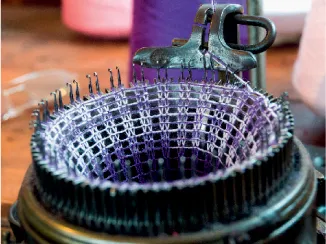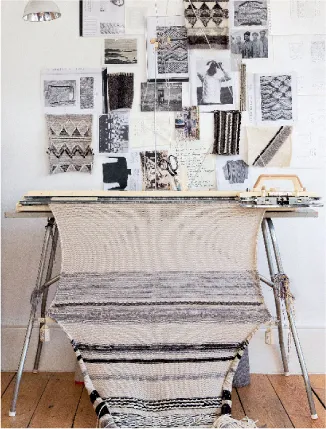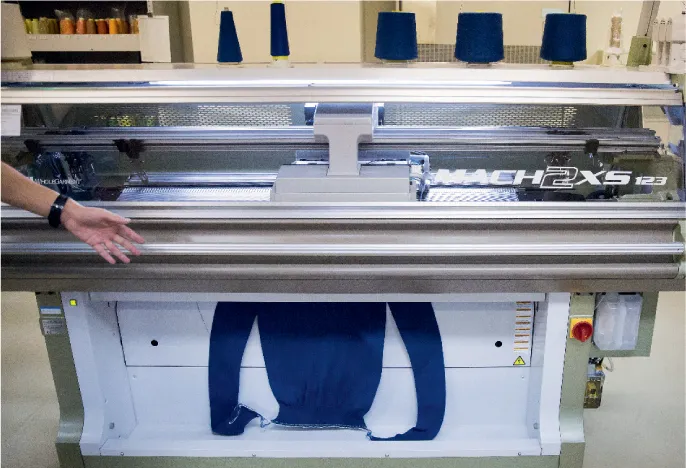![]()
This tactile loop knitting technique creates a voluminous fabric that highlights the harmonious yarn palette. Designed by Sophie Steller Studio.
Part 1
Preparation
![]()
Chapter 1
The Knitting Machine
There are many different types of knitting machine, each with its own purpose and technical abilities. Ranging from simple hobby models to advanced computerized systems capable of creating seamless garments in one piece, they address the exceptional breadth of the knitwear industry.
The flat-bed or single-bed domestic knitting machine is the focus of discussion in this book. This is the most popular kind of machine to learn on, and is ideal for students, home crafters, limited production and small design studios alike. With a little practice, it is quick to master and a fantastic tool for developing knitted fabrics and simple garments.
As the name suggests, a single-bed machine has one needle bed only. Its simplest output is single jersey (also called stocking stitch and plain knitting), a two-sided fabric formed of knit stitches on the face and purl stitches on the reverse. A singlebed machine can be transformed into a double-bed machine by the addition of a ribber, allowing a greater range of outcomes, including ribbed and racked fabrics, tubular structures and knit-and-purl combinations to name a few.
Types of Knitting Machine
Machines used in the industry are broadly categorized as fabric machines or garment-length machines. Fabric machines are mostly circular in configuration and knit continuous lengths of fabric to a set width in tube formation. Once off the machine, the tube is usually sliced open, creating a flat fabric from which garment pieces can be cut. Fabric machines can produce knitted yardage very quickly and efficiently, making them ideal for jersey cut-and-sew garments such as T-shirts. Garments created from these machines are assembled and sewn after they have been cut into pieces of the correct size.
Garment-length machines can be flat-bed or circular and are used to produce outcomes that are knitted to a certain size and shape. Items knitted on circular machines such as hosiery may be used in their tubular formation, whereas flat-bed machines are used to knit individual garment panels.
Some industrial machines are capable of making seamless ‘whole garments’, items such as gloves, legwear and sweaters that are assembled completely on the machine as part of the knitting process, and need minimal finishing. Whereas knitted garment panels consist of separate pieces that must be seamed to create a three-dimensional form, whole garments are knitted entirely without joins, eliminating waste and additional work.
Circular fabric machine, circular sock machine, single-bed domestic machine in designer Emily Watt’s studio, Shima Seiki whole-garment machine, and electronic single-bed domestic machine knitting a design by Catherine Tough.
New developments in machines by companies such as Kniterate are designed to bridge the gap between industrial and domestic models. These electronic machines act as a hybrid between the two, with advanced technical capacity, presented in a more affordable, compact and user-friendly output.
Single-bed machine types
Single-bed machines can be split into three groups: manual, punchcard and electronic. Manual machines are the most affordable, and their simplicity means they are quick to learn on. They have no built-in patterning device, meaning that different stitch types are all performed by hand.
Punchcard machines have a built-in patterning system, allowing the user to knit different stitch types or colours more efficiently within the same row. These machines often come with pre-designed punchcards, but blank cards are also available for you to use to design your own patterns. Punchcard machines are widely available and simple to learn on, and can produce an extensive range of professional-looking outcomes.
Electronic models offer an expanded range of knitted stitches, through built-in or computer-controlled pattern selection. They are typically the most expensive and require more skill from the user.
Knitting machine gauge
The gauge refers to the distance between needles on the bed. This divides machines into four categories of gauges: fine, standard, mid and bulky/chunky. The distance dictates the thickness of yarn that can be successfully used. The chart details the various distances (although the gauge may vary slightly between brands).
Purchasing a machine
When you are considering the purchase of a machine, there are many factors to keep in mind. To determine the machine gauge, think about the types of fabric and garment you want to make and the yarn weights you will most frequently be using. See here for help with this decision and to establish the yarn weights suited to each gauge.
The machine’s technical and patterning capabilities should also be taken into account, since its affordability will depend on its complexity. View the purchase of a machine as an investment; as long as it is used with care and maintained regularly, it should have a long life.
Second-hand machines are available ‘as is’ or refurbished, and can be an excellent alternative to buying new. If buying second-hand, enquire about the machine’s history, current working order and the availability of new parts. If possible, view it in person, and try it out. Acquiring a machine that has been out of use and requires maintenance (besides just cleaning) can be frustrating for a novice knitter.
Knitting machine gauge
How the Machine Works
The mechanics of the machine
Regardless of the single-bed machine type, brand or model, they all create knitted fabric in the same way. The appearance and position of the controls may differ, and some machines may...







